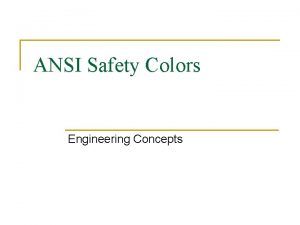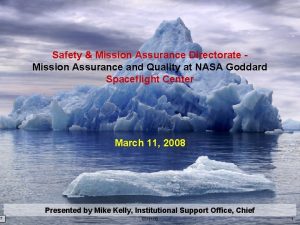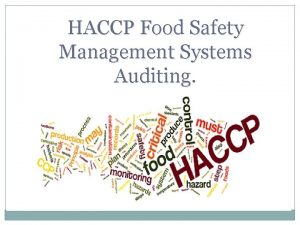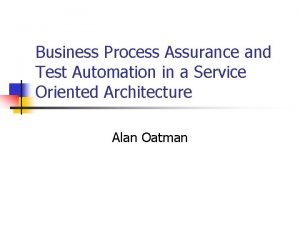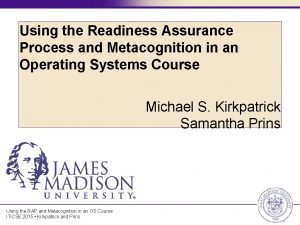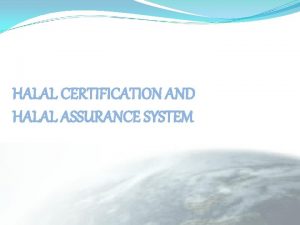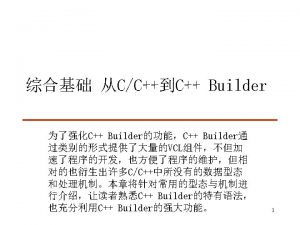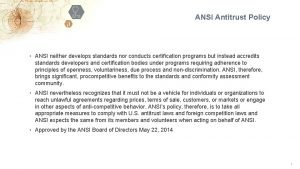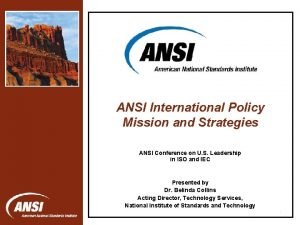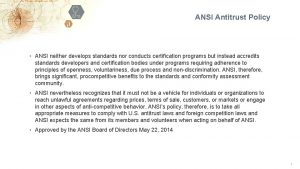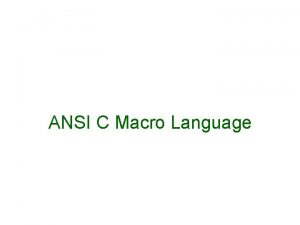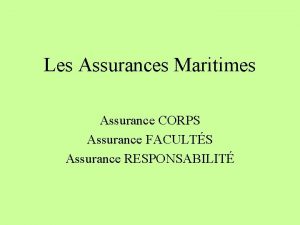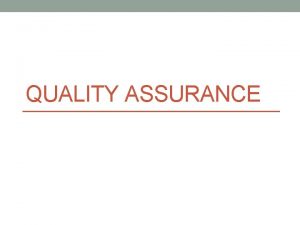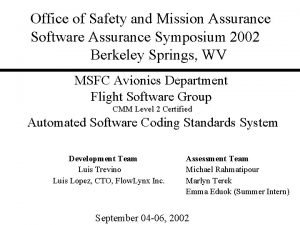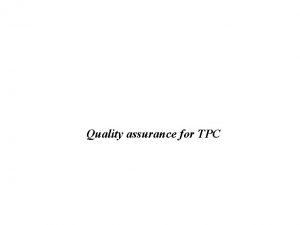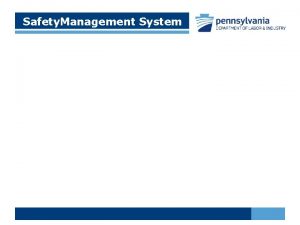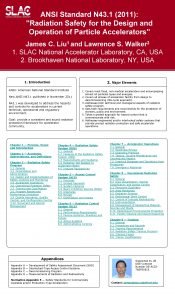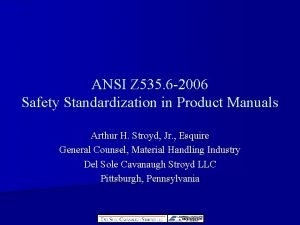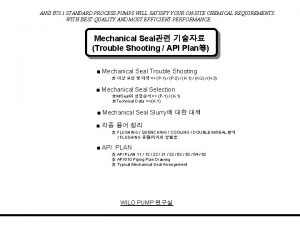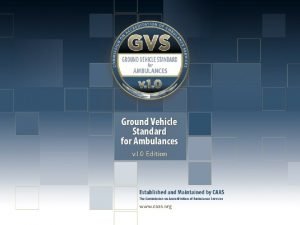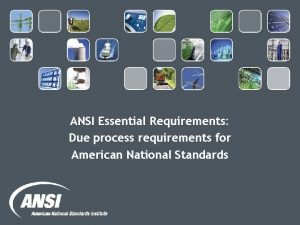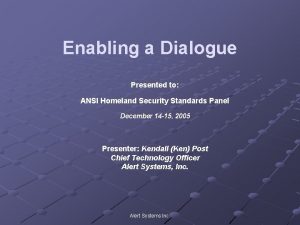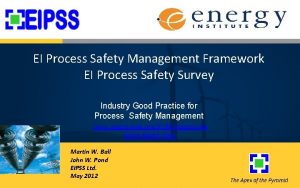The ANSI Process for System Safety Assurance Presented



































- Slides: 35

The “ANSI Process” for System Safety Assurance Presented at the Safety Case Workshop Huntsville, AL; January 14 th, 2014 David B. West, CSP, P. E. , CHMM, Fellow NATIONAL SECURITY • ENERGY & ENVIRONMENT • HEALTH • CYBERSECURITY © SAIC. All rights reserved.

What do we mean by the “ANSI Process”? • The publishing of best practices in ANSI/GEIA-STD-0010 -2009 was done by a working group of the SAE International G-48 System Safety Committee • Best practices are developed and standardized so that the community of practitioners can advance the state-of-the-art • The best practices documented in ANSI/GEIA-STD-0010 -2009 include: • Designing a System Safety Program around 5 basic elements • Using a modernized risk assessment matrix • Describing hazards in terms of their Source, Mechanism, and Outcome • Giving consideration to the concept of Total System Risk • In this workshop, the “ANSI Process” refers to System Safety processes and methodologies outlined in ANSI/GEIA-STD-0010 -2009, “Standard Best Practices for System Safety Program Development and Execution” 2

Outline of Presentation • Brief background on the G-48 System Safety Committee • How standardizing best practices can drive advancements in the state-ofthe-art • The G-48 Committee’s development of ANSI/GEIA-STD-0010 -2009 • The 5 basic elements of an effective system safety program, as presented in ANSI/GEIA-STD-0010 -2009 • Improvements, covered in ANSI/GEIA-STD-0010 -2009, to the traditional risk assessment matrix • The source-mechanism-outcome model for describing hazards • Risk summation 3

Overview of the G-48 System Safety Committee • • • Established in 1966 by the Electronics Industries Association (EIA) System Safety experts from industry, government, military Advisory body to U. S. Govt. on System Safety issues and standards – e. g. , MIL-STD-882 Develops/seeks consensus on System Safety methodologies Three meetings per year Parent organizations after EIA: – – GEIA ITAA Tech. America SAE International (July 2013) • Mission Statement: – To promote the development of safe systems, products, and processes: the G-48 Committee compiles, develops, improves and publishes best practices in the discipline of System Safety. 4

Overview of the G-48 System Safety Committee (Cont. ) 5

Overview of the G-48 System Safety Committee (Cont. ) G-48 Meeting No. 133 – Huntsville, AL – January 2013 6

How standardizing best practices can drive advancements in the state-of-the-art • A key motivating factor in developing ANSI/GEIA-STD-0010 -2009 was the desire to make improvements in the System Safety state-of-the-art. • The next five charts graphically present a notional and non-quantitative picture of how improvements in the practice of any human endeavor can be actively brought about through the standardization of best practices. • This approach for bringing about improvements has been successfully followed in several other fields, including: – – 7 The medical profession Steam boiler design and manufacturing Fire protection in building design The automotive industry

Frequency of Practice Variation of Practice in a Typical Discipline Measure of “Goodness” (Proficiency, Effectiveness, Accuracy, Value, etc. ) 8

Frequency of Practice Standardization Option 1: Define and Document Current Practice Good news: Bad news: Recognition of full spectrum of current practices No improvement; practice stagnates Measure of “Goodness” (Proficiency, Effectiveness, Accuracy, Value, etc. ) 9

Frequency of Practice Standardization Option 2 (Good): Option 1 + Identify Central Tendency & Gradations Good news: Bad news: Substandard practices req’d to improve No improvement for most of the spectrum; practice stagnates Minimally Acceptable Consens us Substandard Exemplary, or State-ofthe-Art Cutting Edge Measure of “Goodness” (Proficiency, Effectiveness, Accuracy, Value, etc. ) 10

Frequency of Practice Standardization Option 3 (Better): Option 2 + Decrease Variation Good news: Bad news: These are pressured to improve… …but these might as well “slack off” Consensus Measure of “Goodness” (Proficiency, Effectiveness, Accuracy, Value, etc. ) 11

Standardization Option 4 (Best): Option 3 + Improve Mean Practice Frequency of Practice Good news: More good news: Overall spectrum of practice improves No sacrifice of gains at the top of the spectrum Measure of “Goodness” (Proficiency, Effectiveness, Accuracy, Value, etc. ) 12

The G-48 Committee’s Development of ANSI/GEIA-STD-0010 -2009 • • • 13 Background: Acquisition Reform and MIL-STD-882 D Identified Opportunities for Improving System Safety Practice The G-48 Committee’s Draft of MIL-STD-882 E “De-militarizing” the Draft 882 E to Form an Industry Standard Revision A of ANSI/GEIA-STD-0010 -2009

The G-48 Committee’s Development of ANSI/GEIA-STD-0010 -2009 Background: Acquisition Reform and MIL-STD-882 D • Acquisition Reform efforts by the U. S. DOD in the late 1990’s resulted in eliminating many military standards • MIL-STD-882 was preserved by making Revision D (Feb 2000) much less prescriptive then it had been in previous revisions (~30 pages, no S. S. tasks, guidance only) • G-48 Committee received much feedback from 2000 -2004 that industry, in general, did not like MIL-STD-882 D • Committee agreed that: – It was time to consider the preparing a revision of MIL-STD-882 – A new revision of MIL-STD-882 provided an opportunity for improving standard practices 14

The G-48 Committee’s Development of ANSI/GEIA-STD-0010 -2009 (Cont. ) Identified Opportunities for Improving System Safety Practice • • No universal understanding as to what basic elements are included in a successful System Safety Program Risk assessment matrix not laid out in Cartesian coordinates (which would have risk increasing up and to the right) Disproportionately scaled risk assessment matrix No quantitative bounds for hazard probability categories; mixed probability and frequency terms No provision for taking hazard exposure interval into account Using approach that if hazard risks – taken individually – are acceptable, then system risk is acceptable (regardless of number or risk level of individual hazards); i. e. , no assessment of total system risk Inconsistent and/or incomplete methods for describing hazards These shortcomings were addressed in the System Safety best practices documented in ANSI/GEIA-STD-0010 -2009. 15

The G-48 Committee’s Development of ANSI/GEIA-STD-0010 -2009 (Cont. ) The G-48 Committee’s Draft of MIL-STD-882 E • In late summer 2004, a preliminary Draft 1 of 882 E was prepared by Chuck Dorney, a longtime G-48 participant, and distributed to the G-48 Committee for review – numerous comments for improvement in late 2004 and early 2005 • All ideas for improvements presented to G-48 Committee in January 2005 • G-48 Action Item 109 -01 was to “produce a strawman Draft MIL-STD-882 E, ‘adding discipline to our discipline’” • An ad hoc working group was formed from several Huntsville-based organizations: APT Research, U. S. Army Aviation & Missile Command, SAIC 16

The G-48 Committee’s Development of ANSI/GEIA-STD-0010 -2009 (Cont. ) 17

The G-48 Committee’s Development of ANSI/GEIA-STD-0010 -2009 (Cont. ) The G-48 Committee’s Draft of MIL-STD-882 E (Cont. ) • Throughout 2005 and into early 2006, the G-48’s 882 E working group held several meetings to incorporate recommendations for improvement • Primary Focus: 1) Simplifying Work Elements and Process Flow 2) Modernizing the Risk Assessment Matrix 3) Introducing Risk Summation 18

The G-48 Committee’s Development of ANSI/GEIA-STD-0010 -2009 (Cont. ) The G-48 Committee’s Draft of MIL-STD-882 E (Cont. ) • February 2006: G-48’s Final Draft MIL-STD-882 E submitted for review and approval through U. S. DOD standardization process • Approved by nearly every DOD standardization member that reviewed it • Key non-concurrence by DOD’s Environment, Safety, and Occupation Health (ESOH) Integrated Process Team (IPT); ESOH IPT took control • G-48 Committee did not want to lose all the improvements that we worked so hard to incorporate. So… 19

The G-48 Committee’s Development of ANSI/GEIA-STD-0010 -2009 (Cont. ) “De-militarizing” the Draft 882 E to Form an Industry Standard • After the key non-concurrences derailed the G-48's Draft 882 E, the Committee embarked on a new effort to rewrite the document as an industry (non-military) best practices standard. • A 3 -person team performed a thorough scrub of the document to remove all militaryspecific terminology, weapon system references, etc. • Result was the first real draft of what would become GEIA-STD-0010 • Additional Improvements: – Emphasis on “Worst Case Risk” to replace “Most Reasonable Credible Mishap” – Added “Engineered Safety Features” (ESF) to System Safety order of precedence – Added guidance to describe hazards in terms of Source – Mechanism – Outcome (SMO) 20

The G-48 Committee’s Development of ANSI/GEIA-STD-0010 -2009 (Cont. ) “De-militarizing” the Draft 882 E to Form an Industry Standard (Cont. ) • GEIA-STD-0010 published in October 2008 • Approved by ANSI in February 2009 and republished as ANSI/GEIA-STD-0010 -2009 21

The G-48 Committee’s Development of ANSI/GEIA-STD-0010 -2009 (Cont. ) Revision A of ANSI/GEIA-STD-0010 -2009 • Feedback received from industry after the original version of GEIA-STD-0010 was released indicated that the standard needed something analogous to the DOD’s Data Item Descriptions, or DIDs • In 2011, an effort was begun to develop Task Data Descriptions (TDDs), where appropriate, for tasks from Appendix B of GEIA-STD-0010 • Approach: – Compare tasks from MIL-STD-882 C to new tasks in GEIA-STD-0010 – Adapt existing DIDs referenced from 882 C to become new TDDs for corresponding tasks in GEIA-STD-0010 – Develop new TDDs where necessary • Purpose of Revision A was stated as: …provide Task Data Descriptions (TDDs) for System Safety Tasks in Annex (sic) B of the Standard. TDDs are analogous to Data Item Descriptions (DIDs) found in military standards. The TDDs will be placed in a new appendix (Appendix C). This revision will also incorporate numerous editorial corrections to the current version of the standard. 22

The Five Basic Elements of an Effective System Safety Program 1) Simplifying Work Elements and Process Flow 2) Modernizing the Risk Assessment Matrix 3) Introducing Risk Summation 23

The Five Basic Elements of an Effective System Safety Program (Continued) 24 Credit: From analysis of various risk management processes and presentation developed by APT Research, Huntsville, AL.

The Five Basic Elements of an Effective System Safety Program (Continued) The Eight Program Elements outlined in MIL-STD-882 D and earlier versions were combined and simplified into five, to provide a more concise representation of current consensus practices. 1. Documentation of the system safety approach 2. Identification of hazards 3. Assessment of mishap risk 4. Identification of mishap risk mitigation measures 5. Reduction of mishap risk to an acceptable level 6. Verification of mishap reduction 7. Review and acceptance of residual mishap risk by the appropriate authority 8. Tracking hazards and residual mishap risk 25 1. Program Initiation 2. Hazard Identification and Tracking 3. Risk Assessment 4. Risk Reduction 5. Risk Acceptance I–A–RA

The Five Basic Elements of an Effective System Safety Program (Continued) 26

Improvements to the Traditional Risk Assessment Matrix • • • Matrix from MIL-STD 882 D Axes converted to logarithmic scales Note: • • 27 Highest risk at upperleft Huge variation in span of risk covered by different cells

A “Pop Quiz” Identify as many ways as possible that the risk matrix at right could be improved - Flip vertical axis to have highest risk at upper-right - Do not mix probability and frequency terms - Provide quantitative bounds for likelihood and consequence scales - Consider changing 4 C, 3 D, and 2 E to High, or Yellow, Risk (Bonus question: Why? ) Good attribute: Numbering of consequence categories 28

Improvements to the Traditional Risk Assessment Matrix Hazard Frequency (Mishaps per <exposure interval>) Hazard Severity 7 Catastrophic 6 $200 M Catastrophic 5 $20 M Catastrophic 4 $2 M Critical 3 $200 K Marginal 2 $20 K Negligible 1 $2 K Designed Out I Near Zero 0 H Extremely Infrequent 0. 00001 Very Infrequent G 0. 0001 F Infrequent Intermittent Occasional E D C 0. 001 0. 01 Typical 4 x 5 Matrix High 100 Fatal “Minimizability” Serious 10 Fatal Medium 1 Fatal Low de minimus Adapted from Fig. 11 of “A Common Mishap Risk Assessment Matrix for U. S. Do. D Aircraft Systems, ” D. Swallom, 23 rd ISSC, 2005. 29 1 X Catastrophic $2 B 1 K Fatal 0. 1 Somewhat Frequent B 10 Frequent A

The Source-Mechanism-Outcome Model for Hazard Descriptions • Previous definitions of “Hazard” did not always, or consistently, require enough information • This model requires a hazard to be described in terms of its: – SOURCE (the physical presence – situation, configuration, material, items, their characteristics, proximity and/or potential for interface, energy, etc. – that exists prior to, and enables, the initiation of an mishap sequence) – MECHANISM (the complete sequence of events – actions, reactions, interactions, etc. – from initiation of the mishap, through to stable end state) – OUTCOME (the end result of the subject accident sequence, specified in terms of the harm that would come to an asset of value; if a range of outcome severities was possible, it is understood that the outcome stated for the described hazard is that which, when paired with the probability of its occurrence, yields the highest risk, or probability-severity combination) • Describing a hazard with this model prompts the analyst to identify ways in which: – The SOURCE can be eliminated, isolated, or otherwise protected – The MECHANISM can be interrupted if it should start – The OUTCOME can be mitigated 30

The Source-Mechanism-Outcome Model for Hazard Descriptions (Continued) Source 31 Mechanism Outcome

The Source-Mechanism-Outcome Model for Hazard Descriptions (Continued) • A Practical Exercise – Improve upon the following hazard descriptions by re-stating them in terms of a SOURCE, MECHANISM, and OUTCOME (be creative and invent the context) • Slippery spot on walkway • Extremely hot surface in microgravity payload canister Pipe carrying oil in the space over narrow walkway (SOURCE) develops a leak; leaked oil accumulates on walkway; person using walkway slips on oil and falls (MECHANISM), sustaining a major injury (OUTCOME) External surface of furnace in payload canister reaches 800○F during normal operation (SOURCE). Emergency abort from orbit necessitates re-entry to atmosphere before surface of furnace can cool; flammable gases in payload bay enter canister and are ignited by hot surface, causing explosion (MECHANISM). Spacecraft disintegrates during descent, causing death of all occupants (OUTCOME). 32

Summation of Total Risk Partial System Risks (r) Assessed Individually: Acceptable Level r 2 r 1 r 2 r 3 r 4 … r 4 rn … rn ? Acceptable Level 33

Summation of Total Risk (Continued) Total System Risk (R) Individual hazard risk (r) n r 1 ≈ i=1 r 2 RISK TOLERANCE r 3 . . . rn 34 Σ (r ) i

Presentation Recap – The work of the Tech. America G-48 System Safety Committee in developing and publishing ANSI/GEIA-STD-0010 -2009 – How a discipline can be advanced by standardizing its best practices – The 5 basic elements of an effective System Safety Program, as outlined in ANSI/GEIA-STD-0010 -2009 – Attributes of a modernized risk assessment matrix – The Source-Mechanism-Outcome model for describing hazards, and how its use helps in the identification of effective hazard controls – The concept of Summation of Total Risk QUESTIONS? 35
 Ansi safety yellow
Ansi safety yellow Personal safety vs process safety
Personal safety vs process safety Gsfc
Gsfc Food safety assurance
Food safety assurance Business process assurance
Business process assurance Readiness assurance process
Readiness assurance process Mui halal certificate
Mui halal certificate Iso 22301 utbildning
Iso 22301 utbildning Novell typiska drag
Novell typiska drag Tack för att ni lyssnade bild
Tack för att ni lyssnade bild Vad står k.r.å.k.a.n för
Vad står k.r.å.k.a.n för Shingelfrisyren
Shingelfrisyren En lathund för arbete med kontinuitetshantering
En lathund för arbete med kontinuitetshantering Personalliggare bygg undantag
Personalliggare bygg undantag Personlig tidbok
Personlig tidbok Sura för anatom
Sura för anatom Vad är densitet
Vad är densitet Datorkunskap för nybörjare
Datorkunskap för nybörjare Boverket ka
Boverket ka Debatt mall
Debatt mall Delegerande ledarskap
Delegerande ledarskap Nyckelkompetenser för livslångt lärande
Nyckelkompetenser för livslångt lärande Påbyggnader för flakfordon
Påbyggnader för flakfordon Tryck formel
Tryck formel Offentlig förvaltning
Offentlig förvaltning Urban torhamn
Urban torhamn Presentera för publik crossboss
Presentera för publik crossboss Argument för teckenspråk som minoritetsspråk
Argument för teckenspråk som minoritetsspråk Bat mitza
Bat mitza Klassificeringsstruktur för kommunala verksamheter
Klassificeringsstruktur för kommunala verksamheter Epiteltyper
Epiteltyper Bästa kameran för astrofoto
Bästa kameran för astrofoto Centrum för kunskap och säkerhet
Centrum för kunskap och säkerhet Verifikationsplan
Verifikationsplan Mat för idrottare
Mat för idrottare Verktyg för automatisering av utbetalningar
Verktyg för automatisering av utbetalningar
